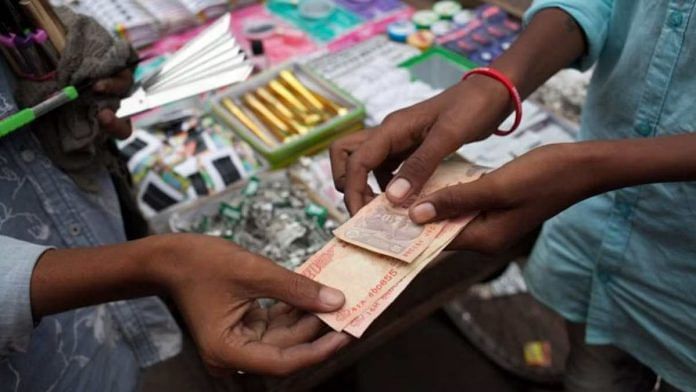Economic commentators are quite liberal with their analyses of the economy, taking to every medium to tell everybody what they think. Meanwhile, the Narendra Modi government is equally parsimonious with any meaningful analysis of its own. The government tries to create a fog of rosiness, highlighting only good news and befuddling the gullible.
But now, the glare of impending elections is burning away this haze and laying bare what the government actually thinks. Hint: It’s not all rosy.
At the outset, let me clarify that this is not about the prime minister’s announcement that the free food programme — the PM Garib Kalyan Ann Yojna (PMGKAY) — will be extended for five years, which many have gleefully taken as his admission of the economy’s weakness. The implications of the announcement have been overstated. It hasn’t even received Cabinet approval yet, though it probably will.
This article instead has to do with several other decisions the government has actually implemented over the last few months. They demonstrate the government’s firm belief in the so-called ‘K-shaped recovery’, despite all the talk about becoming the third-largest economy and remaining the fastest-growing one.
The decisions also highlight the difference between rhetoric and reality, revealed by the bright spotlight of upcoming elections.
Also read: Modi can’t prove India is 5th largest economy. Data will fail him
Government’s business
Let’s get the free food announcement out of the way. Many commentators reacted to Modi’s recent announcement, saying this “proves” that the government thinks 80 crore people can’t survive without free food. First, the 80 crore number is a hangover from the last consumption survey done for 2011-12; the current data is likely lower.
Second, these same commentators would have lambasted the government if it had either discontinued the National Food Security Act 2013 (NFSA) ration or started charging for them again. Critics can’t have it both ways.
Last, the initial free food plan that kicked off on 1 January was only for 2023. As the year winds down, it was expected that the government would extend it. A five-year extension simplifies the process in one go instead of having to renew it every year.
That said, what does show that the government is worried about the distress people are facing is its recent rollout of Bharat Dal and Bharat Atta. Under these brands, the government will sell highly subsidised pulses and flour to the public.
For a government so vocal about privatisation plans and a prime minister who has repeatedly said, “The government has no business to do business”, entering the business of selling food items shows there is considerable alarm about the price of food and the ability of the poor to afford it. With elections nearing, it has no choice but to take action.
That’s not all. The LPG subsidy has been hiked twice in just over a month. The first hike—of Rs 200 per cylinder—was troubling in itself since it was extended to all families and not just the poorer ones benefiting from the PM Ujjwala Yojana. In October 2023, the beneficiaries of the scheme were given an additional Rs 100 per cylinder subsidy.
Earlier in May, the government also stated that its expenditure on fertiliser subsidies would overshoot the budgeted amount for 2023-24 by more than 30 per cent.
Then there’s the emergency allocation of Rs 10,000 crore for the Mahatma Gandhi National Rural Employment Guarantee Scheme (MGNREGS) due to a spurt in demand for work. A higher-than-budgeted demand for MGNREGS work is a direct indication of the weakness in the rural economy.
It’s easy to dismiss most of these decisions as cynical election-related freebies, but the fact remains that they are needed. A Rs 200 per cylinder price reduction for the non-poor, for example, becomes attractive only if incomes aren’t growing.
It’s telling that—with caste issues again at the fore, thanks to Bihar’s recent exercise—Modi chose to say: “The poor are the biggest caste in the country”. This was, of course, primarily a political comment, but also an economic one: Concentrate on the poor.
On the flip side, it’s reasonably clear that the government believes the top 1 per cent of the population is doing just fine. Of course, it won’t come out with election-related schemes for the rich, but it is going out of its way to woo companies like Tesla and Lotus (which typically sell cars priced in the crores), and Apple. These ultra-premium companies are expected to not only invest but also sell in India. The top prong of the ‘K’ will be doing the buying.
Also read: Modi govt turning into Big Brother. Overly-protective TCS policies infantilising citizens
May to now
Not too long ago, in May, Chief Economic Adviser V Anantha Nageswaran had said that the economy was running on autopilot and the government saw no need to interfere. The only unexpected change since then has been the Israel-Hamas war, which, so far, has not hurt India economically in any significant way.
This begs the question: Has the economy deteriorated rapidly since May, or was the government’s sanguinity at the time just rhetoric?
What’s clear is that the impending Lok Sabha election is taking away the government’s ability to obfuscate. Pay keen attention. The next few months will tell you far more than the last four years have.
Views are personal.
(Edited by Ratan Priya)



